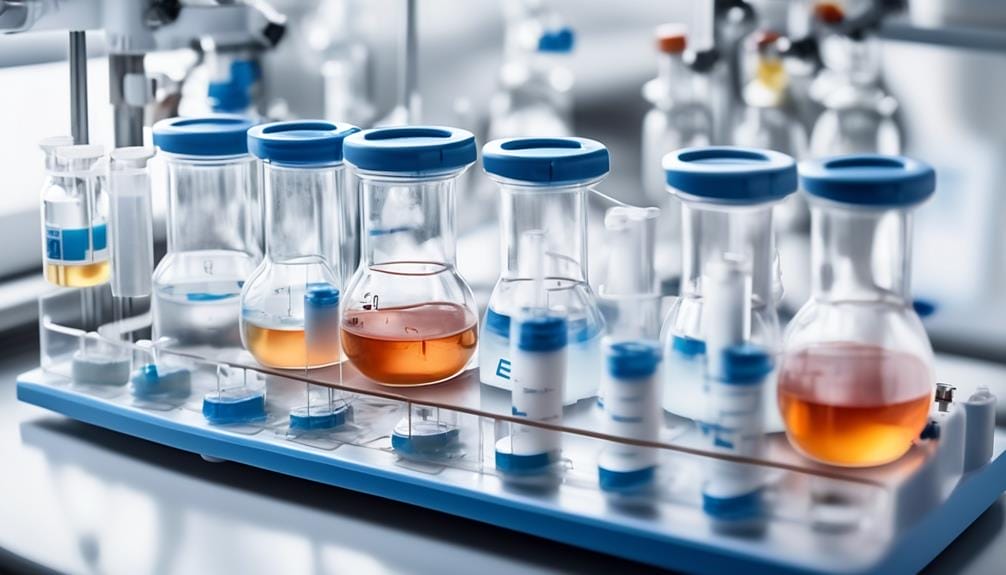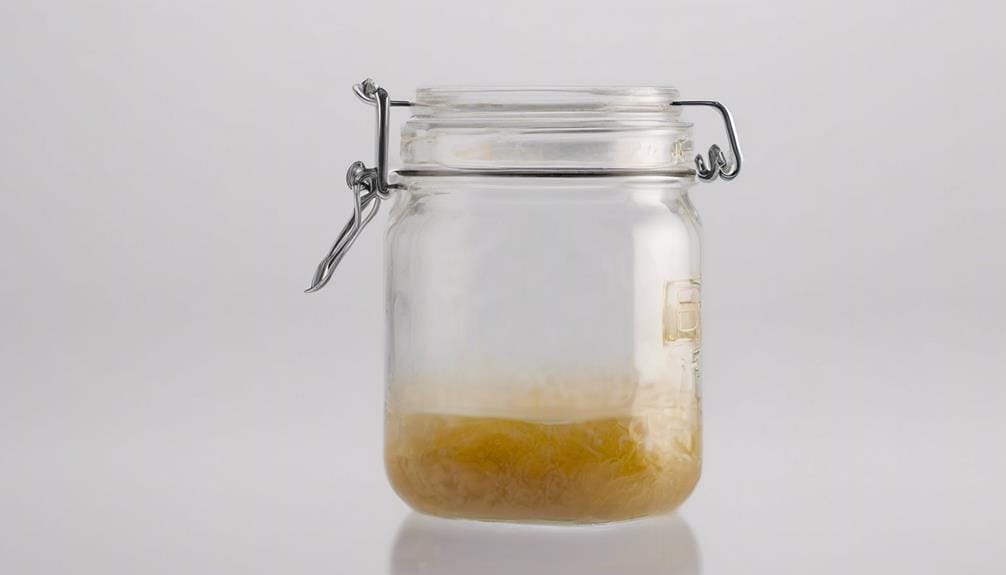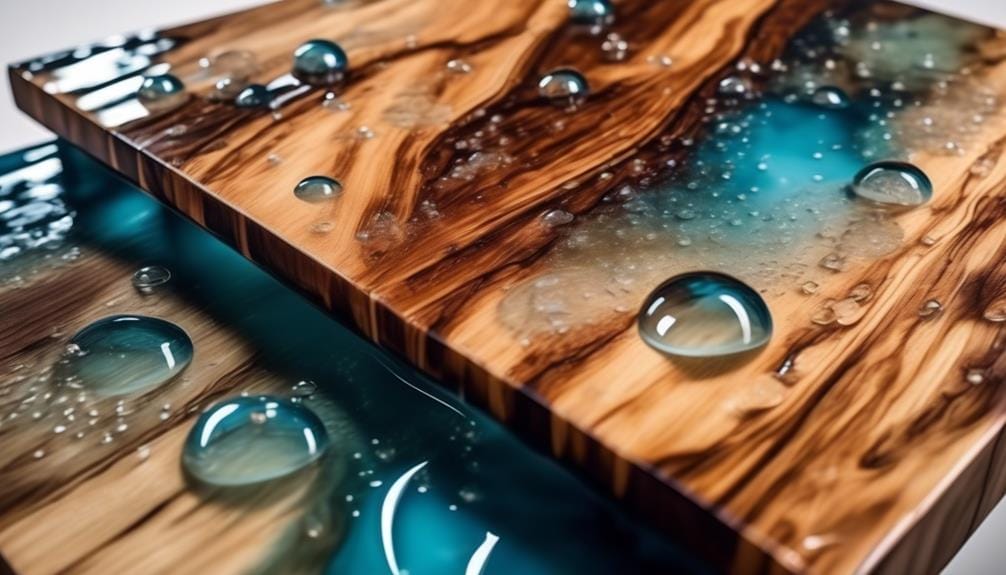Imagine you're sailing on a vast ocean, with nothing but the horizon stretching out before you. Just like the sturdy hull of a ship that keeps you safe from the relentless waves, epoxy resin offers a protective shield against the damaging effects of water.
But what makes epoxy resin so remarkably water-resistant? How does it withstand the constant assault of moisture and keep your projects secure?
In this discussion, we will explore the fascinating world of epoxy resin and its water resistance, uncovering the secrets behind its durability and uncovering tips to maximize its effectiveness.
Get ready to embark on a journey where the power of water meets the resilience of epoxy resin.
Key Takeaways
- The type of epoxy resin used can affect its water resistance.
- Thicker epoxy resin coatings generally provide better water resistance.
- Proper coverage of the entire surface is crucial to prevent weak spots or gaps.
- Additives, such as silicones and hydrophobic materials, can enhance the water resistance of epoxy resin.
Factors Affecting Water Resistance
To understand the factors affecting water resistance of epoxy resin, it's important to examine key variables that play a crucial role in determining the durability and performance of the material. The waterproof nature of epoxy resin is attributed to its unique chemical composition and the way it cures. The epoxy resin consists of two components – a resin and a hardener – which, when mixed together, undergo a chemical reaction known as curing. This curing process forms a strong, cross-linked network of polymer chains that make the epoxy resin highly resistant to water penetration.
However, certain factors can affect the water resistance of epoxy resin. The first factor to consider is the epoxy-to-hardener ratio. Maintaining the correct ratio is crucial, as an imbalance can result in an incomplete cure, leading to reduced water resistance. Additionally, the curing time and temperature must be carefully controlled to ensure proper cross-linking and optimum water resistance.
Another important factor is the surface preparation before applying the epoxy resin. A clean and dry surface is essential for achieving good adhesion and maximum water resistance. Any contaminants or moisture present on the substrate can compromise the epoxy resin's ability to form a strong bond and resist water infiltration.
Furthermore, the quality and type of epoxy resin used can also impact water resistance. Different epoxy formulations have varying degrees of water resistance, with some being specifically designed for waterproof applications. Choosing the right epoxy resin that meets the desired water resistance requirements is crucial for achieving long-lasting and reliable results.
Understanding Epoxy Resin Properties
To understand epoxy resin properties, you need to consider water resistance levels, factors affecting water resistance, and testing methods.
Water resistance is crucial for protection against moisture and corrosion.
Factors like the type and thickness of epoxy resin, as well as curing time, play a significant role in determining its water resistance capabilities.
Proper testing is essential to ensure the desired level of water resistance is achieved.
Water Resistance Levels
Water resistance levels are an important aspect to consider when understanding the properties of epoxy resin. Using waterproof epoxy can provide a reliable and durable solution for a wide variety of applications.
Different types of epoxy resin offer a variety of properties, allowing you to choose the most suitable option for your specific needs. By utilizing waterproof epoxy, you can benefit from its ability to form a waterproof and anti-corrosive layer of protection. This makes it ideal for home improvement projects such as sealing leaks, repairing water damage, or creating water-resistant surfaces.
The superior bonding strength and permanent, weather-resistant nature of cured epoxy resin make it a valuable choice for achieving long-lasting waterproofing results.
Factors Affecting Water Resistance
The water resistance of epoxy resin is influenced by various factors, including the type of resin used, its thickness, curing time, ambient workspace temperature, and material mixing ratios. These factors play a crucial role in determining the effectiveness of epoxy resin as a waterproofing material.
Here are four key points to consider:
- Type of resin: Different types of epoxy resin offer varying levels of water resistance. Some resins are specifically designed for superior waterproofing capabilities, while others may be more suitable for other applications.
- Thickness: Thicker layers of epoxy resin tend to provide better water resistance. A thicker coating creates a more effective barrier against water penetration.
- Curing time: Proper curing is essential for achieving optimal water resistance. It's important to follow the manufacturer's instructions regarding the recommended curing time to ensure the resin fully cures and forms a durable, waterproof seal.
- Ambient workspace temperature and material mixing ratios: The temperature during the curing process and the accurate mixing ratios of the resin and hardener can significantly impact the water resistance properties of the epoxy resin. It's crucial to maintain the recommended temperature range and follow the proper mixing ratios for optimal waterproofing results.
Testing Epoxy Resin
Understanding the properties of epoxy resin involves comprehensive testing and evaluation of variables such as type, thickness, curing time, and safety precautions.
To test the waterproofing capabilities of epoxy resin, you can conduct a simple sink basin test. First, ensure the sink basin is clean and dry. Apply a thin layer of epoxy resin to the surface, making sure to cover any cracks or imperfections. Allow the resin to cure according to the manufacturer's instructions.
Once cured, fill the sink basin with water and check for any signs of leakage or water absorption. If the epoxy resin is water repellent and successfully seals the surface, it will prevent any leaks or water damage.
Remember to always follow safety precautions when handling epoxy resin, such as wearing gloves and working in a well-ventilated area.
Importance of Water Resistance in Epoxy Resin
Achieving optimal water resistance is crucial when using epoxy resin to ensure superior protection against moisture, impact, and corrosion. Water can cause significant damage to surfaces, leading to decay, mold growth, and structural deterioration.
Here are four reasons why water resistance is important in epoxy resin:
- Prevents moisture penetration: Epoxy resin with excellent water resistance forms a barrier that prevents water molecules from infiltrating the surface. This barrier effectively seals off the substrate, reducing the risk of water-related damage.
- Enhances durability: Water-resistant epoxy resin provides long-lasting protection against impact and corrosion. It creates a tough, resilient layer that can withstand harsh environmental conditions, including exposure to water, chemicals, and UV radiation.
- Minimizes the risk of leaks: Epoxy resin's ability to resist water ensures a reliable seal, making it an ideal choice for applications where leak prevention is crucial. Whether used in plumbing or marine repairs, its water resistance helps maintain the integrity of the epoxy system and prevents leaks.
- Versatility in applications: The importance of water resistance in epoxy resin is evident in its diverse applications. From waterproofing concrete structures to protecting electronic components from water damage, epoxy resin's ability to withstand water exposure makes it a versatile choice in numerous industries.
Evaluating Epoxy Resin's Resistance to Water Damage

To determine the resistance of epoxy resin to water damage, it's essential to evaluate factors such as the type and thickness of the resin, application conditions, and post-application considerations.
The type of epoxy resin used plays a crucial role in its water resistance. Some epoxy resins are specifically formulated to be highly resistant to water, while others may have lower resistance. Additionally, the thickness of the epoxy resin coating can impact its ability to withstand water damage. Thicker coatings generally provide better water resistance compared to thinner ones.
When evaluating epoxy resin's resistance to water damage, it's important to consider the application conditions. Factors such as curing time and ambient temperature can influence the resin's ability to bond and create a waterproof barrier. It's essential to follow the manufacturer's guidelines regarding curing time and application temperature to ensure optimal water resistance.
Furthermore, post-application considerations are vital for maintaining the epoxy resin's resistance to water damage. For example, proper coverage of the entire surface is crucial to ensure that no weak spots or gaps are present in the coating. Regular inspections should be conducted to identify any signs of water damage, such as peeling or discoloration.
Enhancing Water Resistance With Additives
Consider incorporating additives into your epoxy resin to enhance its water resistance for specific applications. By adding the right additives, you can improve the waterproofing properties of your epoxy resin, making it more resistant to water damage.
Here are four additives that can help enhance the water resistance of epoxy resin:
- Silicones: Silicones have excellent water repellency properties, making them a popular choice for improving the water resistance of epoxy resin. By incorporating silicone additives, you can create a hydrophobic barrier that prevents water from penetrating the resin.
- Flexibilizers: Flexibilizers increase the flexibility of epoxy resin, allowing it to withstand water exposure without cracking. These additives improve the resin's ability to handle variations in temperature and humidity, making it more resistant to water damage over time.
- Hydrophobic materials: Adding hydrophobic materials to epoxy resin can create a water-resistant barrier within the resin matrix. These materials repel water and prevent it from seeping into the epoxy, enhancing its overall waterproofing capability.
- Contextually relevant additives: When choosing additives to enhance water resistance, it's crucial to consider the specific requirements of your project. Depending on the application, different additives may be more suitable. Evaluate factors such as exposure to moisture, temperature fluctuations, and the desired level of water resistance to determine the most appropriate additive for your epoxy resin.
Testing Methods for Epoxy Resin's Water Resistance

When testing the water resistance of epoxy resin, there are several techniques you can employ.
One method involves immersing the resin samples in water for a specified duration and examining them for signs of water intrusion or damage.
Another approach is to measure the amount of water absorbed by the resin over time, which helps assess its resistance to water penetration.
Additionally, subjecting the resin to high humidity conditions or rapid wet and dry cycles can simulate long-term water exposure and evaluate its durability.
Testing Techniques
Various testing methods are employed to assess the water resistance of epoxy resin, including immersion, spray, humidity chamber, and accelerated aging tests.
- Immersion tests: The epoxy resin sample is submerged in water for a specific duration. Any changes in weight, dimensions, or mechanical properties are evaluated to determine its water resistance.
- Spray tests: The epoxy resin is exposed to continuous or intermittent water spray, simulating real-life conditions. This test assesses its resistance to water penetration and surface degradation.
- Humidity chamber tests: The epoxy resin is exposed to controlled humidity levels, monitoring for signs of moisture absorption, delamination, or loss of adhesion over time.
- Accelerated aging tests: These tests predict the long-term water resistance of epoxy resin by simulating prolonged exposure to harsh environmental conditions, including water. They assess its durability and performance.
Water Immersion Duration
To assess the water resistance of epoxy resin, testing methods involve submerging cured samples in water for specific durations to evaluate any water absorption or degradation. These immersion durations can range from 24 hours to 7 days or longer, depending on the desired evaluation period. By subjecting the epoxy resin to prolonged water exposure, the ability of the material to withstand water penetration and degradation can be determined. The following table provides an overview of typical immersion durations used in water resistance testing for epoxy resin:
| Immersion Duration | Evaluation Period |
|---|---|
| 24 hours | Short-term |
| 7 days | Medium-term |
| Longer periods | Long-term |
These immersion durations help assess the suitability of epoxy resin for waterproofing applications in various industries, such as sink and countertop installations. It is important to consider the specific requirements of the application and select the appropriate immersion duration to ensure the epoxy resin's long-term water resistance and durability.
Applications of Water-Resistant Epoxy Resin
Epoxy resin, with its versatile applications and strong bonding strength, is commonly used to waterproof and protect a wide range of materials such as wood, metal, glass, rubber, masonry, and plastic. Its water-resistant properties make it an ideal choice for various applications.
Here are some common applications of water-resistant epoxy resin:
- Plumbing: Epoxy resin is often used in plumbing applications to seal and repair leaks in pipes, fittings, and fixtures. Its water resistance ensures long-lasting protection against leaks and corrosion.
- Marine: Epoxy resin is widely used in marine applications due to its ability to withstand the harsh and corrosive marine environment. It's used for boat repairs, hull coatings, and sealing underwater structures.
- Construction: Epoxy resin is used in construction for waterproofing basements, foundations, and concrete structures. It provides a protective barrier against water damage and helps prevent moisture intrusion.
- DIY Projects: Epoxy resin is popular among DIY enthusiasts for various projects such as coating countertops, creating decorative pieces, and sealing wooden furniture. Its water resistance ensures durability and protection against spills and moisture.
Considerations for Waterproofing With Epoxy Resin

When considering waterproofing with epoxy resin, it is important to take into account several factors to ensure optimal results. Epoxy resins are widely used for their excellent bonding properties and can effectively seal and protect various surfaces from water damage. However, to achieve a successful waterproofing application, there are a few key considerations to keep in mind.
Firstly, it is crucial to prepare the surface properly by cleaning and removing any existing coatings, dirt, or debris. This will ensure maximum adhesion and prevent any potential leaks or weak spots. Additionally, it is important to choose the right type of epoxy resin for the specific application. There are different formulations available that cater to various requirements, such as temperature resistance or flexibility.
To further emphasize these considerations, the following table highlights key factors to consider when waterproofing with epoxy resin:
| Factors to Consider | Importance |
|---|---|
| Surface Preparation | High |
| Epoxy Resin Selection | High |
| Application Technique | Medium |
| Curing Time | Medium |
| Maintenance | Low |
Common Challenges in Maintaining Water Resistance
Maintaining water resistance with epoxy resin can present various challenges, especially when it comes to temperature fluctuations and exposure to UV rays. These common challenges can affect the longevity and effectiveness of the epoxy resin's waterproofing capabilities.
Here are some common challenges in maintaining water resistance with epoxy resin:
- Cracking from temperature fluctuations: Epoxy resin, when subjected to extreme temperature changes, can expand and contract, leading to cracks in the coating. These cracks can compromise the waterproofing properties of the epoxy resin, allowing water to seep through.
- Premature yellowing from UV exposure: Clear epoxy resin is susceptible to yellowing when exposed to UV rays. This can occur when the epoxy is used outdoors or in areas with high sunlight exposure. The yellowing not only affects the appearance but can also impact the resin's ability to repel water effectively.
- Wood cracking in freezing conditions: Epoxy resin-coated wood may experience cracking when exposed to freezing temperatures. The expansion and contraction of the wood due to freezing conditions can cause the epoxy coating to fail, leading to water infiltration.
- Regular cleaning and maintenance: To maintain the water resistance of epoxy resin, regular cleaning and maintenance are essential. This includes removing any dirt, debris, or contaminants that may compromise the waterproofing properties. Additionally, applying a fresh coat of epoxy resin periodically can help reinforce the water resistance.
Tips for Maximizing Epoxy Resin's Water Resistance

To maximize the water resistance of epoxy resin, it is important to ensure thorough coating of surfaces and follow recommended curing times and ambient temperature guidelines. This will help create a strong and durable barrier against water penetration. Additionally, there are several tips that can further enhance the water resistance of epoxy resin.
Firstly, it is crucial to use the right type and thickness of epoxy resin for specific waterproofing tasks. Different epoxy resins have varying levels of water resistance, so choosing the appropriate one for your project is essential. Additionally, applying epoxy resin on a clean and dry surface is crucial for optimal water resistance. Any contaminants or moisture present on the surface can compromise the adhesion and effectiveness of the epoxy resin.
Furthermore, when using clear epoxy resin outdoors, it is important to consider UV exposure and potential yellowing. UV-resistant epoxy resins are available and should be used to prevent discoloration and maintain water resistance over time.
The following table summarizes the tips for maximizing epoxy resin's water resistance:
| Tips for Maximizing Epoxy Resin's Water Resistance |
|---|
| Ensure thorough coating of surfaces |
| Follow recommended curing times and temperature |
| Use the right type and thickness of epoxy resin |
| Apply epoxy resin on a clean and dry surface |
| Consider UV exposure and potential yellowing outdoors |
Waterproofing Techniques for Epoxy Resin Surfaces
Waterproofing epoxy resin surfaces requires careful application techniques and consideration of specific environmental factors. To ensure optimal water resistance, follow these techniques:
- Surface Preparation: Properly prepare the surface by cleaning it thoroughly to remove any dust, dirt, or grease. This will ensure better adhesion and prevent any contaminants from compromising the waterproofing capabilities of the epoxy resin.
- Mixing Ratio: Follow the manufacturer's instructions and mix the epoxy resin and hardener in the correct ratio. An improper ratio can lead to incomplete curing and decreased water resistance.
- Application Method: Apply the epoxy resin evenly and smoothly using a brush, roller, or spray gun. Avoid applying the epoxy resin too thickly, as this can result in uneven curing and reduced water resistance. Multiple thin coats are often more effective than a single thick coat.
- Curing Time and Environment: Allow the epoxy resin to cure in a controlled environment with proper ventilation and temperature. Factors such as humidity, temperature, and airflow can affect the curing process and the final water resistance of the epoxy resin.
Future Developments in Water-Resistant Epoxy Resin

Ongoing research in the field of epoxy resin is focused on developing formulations with enhanced water resistance, aiming to provide superior protection against moisture, impact, and corrosion.
One area of future development lies in improving the UV resistance of water-resistant epoxy resin. This is crucial for applications exposed to sunlight, as prolonged exposure can cause yellowing and degradation. By enhancing the UV resistance, epoxy resin can maintain its appearance and structural integrity for longer periods, making it suitable for outdoor use.
Additionally, researchers are exploring methods to optimize the waterproofing ability of epoxy resin for specific applications. For instance, in wood sealing, temperature fluctuations can lead to cracking and water ingress. By improving the waterproofing properties, epoxy resin can effectively seal wood surfaces, preventing moisture penetration and potential damage.
Furthermore, advancements in epoxy technology may lead to the creation of new formulations tailored for marine applications. These formulations would offer enhanced waterproofing and durability, making them ideal for boat construction and underwater bonding.
Lastly, the future of water-resistant epoxy resin may involve the development of eco-friendly formulations. These formulations would maintain superior waterproofing properties while minimizing environmental impact, aligning with the growing demand for sustainable materials.
Frequently Asked Questions
Is Epoxy 100% Waterproof?
Yes, epoxy is 100% waterproof. It is a durable material that can withstand moisture and is commonly used for waterproofing techniques. Epoxy resin has various applications and is suitable for outdoor environments.
What Happens if Epoxy Resin Gets Wet?
If epoxy resin gets wet, it may absorb moisture, affecting the curing process and reducing its adhesion. However, once fully cured, epoxy resin becomes waterproof and durable in wet conditions, making it suitable for various applications.
How Long Until Epoxy Is Waterproof?
Once epoxy resin has fully cured, it becomes waterproof. The curing process can take 24 to 72 hours, depending on the resin. To ensure waterproofing, coat the entire surface and follow best practices for application.
Does Epoxy Degrade in Water?
Epoxy resin does not degrade in water due to its chemical composition. Factors affecting its water resistance include curing time and temperature. Common applications include marine coatings and waterproofing. ASTM D570 is a testing method for epoxy's water resistance. Epoxy is more water resistant than other materials like wood or metal.
Conclusion
In conclusion, the water resistance of epoxy resin is a crucial characteristic that ensures its reliability and durability in various applications. Its ability to form a waterproof and non-corrosive surface makes it ideal for marine environments, plumbing repairs, and waterproofing projects.
By understanding the factors affecting water resistance, enhancing it with additives, and implementing proper maintenance techniques, epoxy resin can provide long-lasting protection against moisture and water damage.
The future holds promising developments in water-resistant epoxy resin, further enhancing its performance and versatility.





